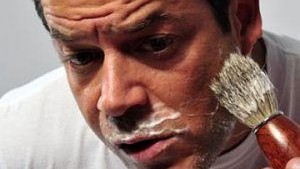
Isn’t Spanish television in extraordinarily rude health? With such a wealth of talent and so many brave, groundbreaking programs, perhaps we’re looking at a new Spanish Golden Age – A Golden Age of the small screen.
Before you hoot with derision at the above, consider this: it’s not a complete lie. I admit, when flicking through the channels, I too shake my fist at the screen as yet another herd of botoxed, inbred celebrities hog the camera’s attentions; I sigh with resignation as another cameraman with the shakes films the home of a Spaniard who is quite dull in every respect except, apparently, for the fact he or she lives abroad; and my eyelids droop as TVE’s interminable news program crawls into its second half hour.
No, Spanish television is not in a Golden Age. But there is hope, even though my optimism is based almost entirely on having watched two episodes of the six-parter ¿Qué fue de Jorge Sanz? (Whatever happened to Jorge Sanz?).
The premise is simple: each episode follows the difficult life of Jorge Sanz, a former child actor and the twenty-something heartthrob who featured in Spanish movie successes such as Amantes and Belle Époque. Nowadays, Sanz is a lived-in 41, without the looks or boyishness that once sent his career skyrocketing. In the David Trueba-directed series, Jorge Sanz plays Jorge Sanz, a has-been film actor with a messy personal life. It’s a manipulative framework and it’s also a brilliant one: ¿Qué fue de Jorge Sanz? plays mercilessly with our memories of the actor and his own career baggage (Trueba even uses excerpts of Sanz’s old films during the 30-minute episodes) and the result is sometimes sad and often hilarious.
Part of its success is due to Sanz’s brilliance at playing “himself”. While we may wonder how much of the real Jorge Sanz has gone into this role, the actor plays it with a naturalness that is rarely seen on the Spanish small screen. The details are also wonderfully telling. During a visit to Barcelona, his ex-partner’s new boyfriend sits on top of him and performs some painful massage techniques to fix Jorge’s back, before sticking the knife in by asking the prostrate, Madrid-born actor: “Do you follow Catalan cinema? There’s some great new talent…” Even the theme music has been lovingly created. Sounding like an outtake from The Band’s Music from the Big Pink, its aching melancholy is pitch perfect.
Comparisons are easy to make, most obviously with Curb Your Enthusiasm, in which Larry David plays the hapless “Larry David” to comic effect. Also, Ricky Gervais’ (overrated) Extras, especially given that series’ out-of-work-actor premise. But if Spanish TV is going to borrow ideas from abroad, they may as well be substantial, character-driven ideas, rather than formulas for reality shows or lost-in-translation formats such as Saturday Night Live (remember the Spanish version? No, nor do I).
“David told me the best character for me to play right now was…me,” Sanz told Digital +, which is broadcasting the series. The actor added that making the episodes was “like free psychoanalysis.”
But watching it, I can’t help feeling that it’s not Jorge we’re feeling sorry for or laughing at, but ourselves. “Jorge Sanz is a real presence in our memories of cinema and television,” Trueba has written. “He’s an actor who has spent over 30 years in the job, who has grown up with us. The challenge for this series is really quite simple: that the person who sits down to watch ¿Qué fue de Jorge Sanz? asks himself the question: whatever happened to me?”
Another craggy forty-something
My optimism might be a little over-the-top were it not for the fact that Jorge Sanz came on the heels of another six-part series with a craggy forty-something male lead. Todas las mujeres saw the excellent Eduard Fernández trying to resolve his criminal and personal problems through meetings with six different women in his life. The David Mamet-like experiment never quite reached the heights it aimed for, but it is nonetheless a bold work of television.
Both series have aired on pay channels, with Todas las mujeres, on TNT, being the first original Spanish production showed on a subscription broadcaster. And looking back at the purple patch of drama series that the United States has enjoyed over the last decade, it’s no coincidence that pay channels have been at the forefront of that renaissance (most notably HBO, which started the ball rolling with The Sopranos and more recently showed The Wire).
So, is this the beginning of a similar Golden Age in Spain? Probably not. But if the subscription channels can attract some of the country’s substantial cinema talent and enough viewers, then maybe this kind of quality will be produced more frequently. In the meantime, you’ll have to excuse me, I must get back to the latest episode of Españoles en el mundo…
‘¿Qué fue de Jorge Sanz?’ is broadcast on Fridays at 9.15pm on Digital +
Leave a Reply
You must be logged in to post a comment.